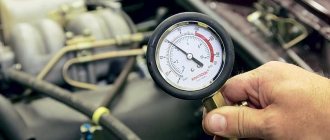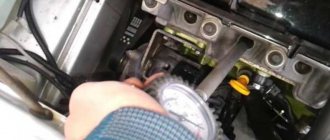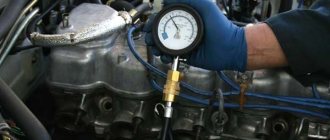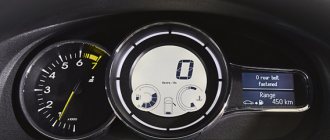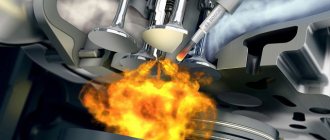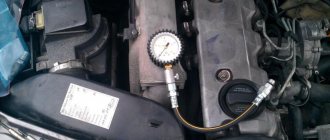A car engine is a complex unit, the performance of which directly depends on the proper operation of all components. At the same time, during the operation of the vehicle, the driver may encounter a loss of power, difficulty starting the engine, as well as an increase in fuel and engine oil consumption.
As a rule, a fairly common problem that is associated with engine wear and certain breakdowns is a decrease in compression. Low compression leads to the fact that the engine starts poorly, traction and power are lost, and there is excessive consumption of fuel and lubricant. Next we will talk about why compression in the engine disappears, as well as what the driver should do if the compression in the cylinders is low.
Does compression always indicate engine health?
Before we consider the signs and reasons why there is no compression in one or more cylinders, we will analyze whether this parameter affects the performance of the power unit. If the pressure in the lubrication system of a 406 or other engine is below normal, in practice this indicates wear of the internal combustion engine components. But it is not always the case. When mating the piston rings with the plane of the cylinders, it is the lubricating fluid that collects on the walls of the engine that plays an important role. Thanks to engine oil, the interface of the components is sealed.
When not all of the air-fuel mixture burns in the power unit, this leads to an increase in fuel consumption. If spark plugs fail, fuel will wash motor fluid from the walls of the engine, because gasoline is a good solvent. And if there is no lubricant in the system, there will be nothing to seal the combustion chamber with. Accordingly, because of this, air under pressure will begin to enter the crankcase of the power unit. This leads to the fact that in a 4-6- and 8-cylinder internal combustion engine, compression will drop sharply and disappear.
If its level is normal or higher than necessary, this will cause increased consumption of motor fluid. Due to increased compression, the rings wear out faster. And the gaps formed as a result of wear will begin to be sealed with lubricant, which is in abundance. This problem requires prompt repair. But in fact, compression does not show such a malfunction.
You will learn how to correctly perform the diagnostic procedure from the video published by the AssistanceTV channel.
Optimal cylinder pressure
To determine the moment of critical wear of the cylinder-piston group, you need to know what compression rate is considered satisfactory. Here there is a relationship with the compression ratio - the higher it is, the greater the pressure that occurs in the combustion chambers when the crankshaft rotates.
At the moment there are 3 types of motors with different parameters:
- old power units with a low compression ratio (up to 8.5);
- modern gasoline engines, where the fuel mixture is compressed 9–11 times;
- diesels with a compression ratio of 16–24.
The combustion chamber of a diesel engine is small in size, so ignition of diesel fuel occurs due to strong compression.
Signs of a drop or loss of pressure
Let's look at the symptoms that can be used to determine weak and low compression in all, two or the first cylinder. If your blood pressure is low or absent, the signs are:
- Difficulty starting the power unit. In order to start it, the driver needs to turn the starter longer. And as a result of a complete loss of pressure, the engine cannot be started at all.
- The engine began to function less stable. Due to the drop in compression, its speed at idle and when driving in gear will be unstable.
- Increased fuel consumption. At first glance, identifying this symptom is problematic, but if you monitor this parameter, you can calculate it.
- Problems appear in the functioning of the cylinders. When going uphill, there is a knocking sound from the hydraulic compensators (“fingers”). This is especially obvious when driving at low speeds.
- In a diesel engine, the problem manifests itself as popping noises.
- The pressure in the cooling system lines may increase. As a result, antifreeze will begin to squeeze out from under the sealing elements.
- If there is poor compression in one or more cylinders and this is due to damage to the cylinder head gasket, then the tightness of the system as a whole is compromised. By opening the hood, you can diagnose this problem by the presence of exhaust gases that exit through the gap that appears. Such a malfunction leads to stuck piston rings, which ultimately increases fuel and oil consumption. In some vehicles, this symptom is complemented by an increase in the power of the power unit and the appearance of abundant smoke from the muffler.
Mechanical problems
If a 4-cylinder or larger power unit works, but there is no compression, then the reasons may be mechanical. Compression suddenly disappears for one of the following reasons:
- The exhaust valves are most often damaged. Cracks can often be observed on the valve. This is due to natural wear and tear on the engine. The valve does not fit sufficiently against the seat in the cylinder head. That's why there is no compression in cylinder 2.
- Also one of the reasons is wear of the valve seat. Reduced or absent compression is explained by mechanical damage. Often the saddle is pressed through.
- A popular reason is a burnt gasket between the engine block and the head. Experts are sure that this is an inevitable situation, which occurs due to the high mileage of the car. A little less often, the cause of gasket burnout is dirt getting on the plane. This problem is encountered when the engine is operated for a long time at elevated temperatures. The cylinder head cracks and the block becomes deformed.
- Mechanical reasons for low compression include scuffing in the combustion chambers. There are many reasons for the formation of scuffing, but the most common is overheating. If the piston ring inside the cylinder breaks, this leads to scoring. Damage to parts of the CPG also leads to a decrease in compression. For example, inter-ring bridges on pistons often break.
- If the timing belt breaks, there will be no pressure in all cylinders and the engine will not be able to start.
- Intake valves fail. Cracks form on the pistons or cylinder walls. Carbon deposits appear on valve seals and rings. All this helps reduce compression.
A sharp drop in compression can lead to very serious problems in the operation of the power unit. If there is no pressure in one of the cylinders, then diagnostics must be performed. Next, we'll look at how to check compression in cylinders.
How long will the engine last?
Low pressure is a problem that car enthusiasts often face. If the drop is insignificant, then the engine can be operated for a long time. But keep in mind that too little compression or its complete absence may be due to the strong heating of the unit.
Long-term operation of a car with an overheated internal combustion engine will eventually lead to its complete failure.
Detailed instructions for measuring pressure in engine cylinders are given below and filmed by the Made in Garage channel.
How to troubleshoot
The first thing to do is check the compression in the engine cylinders using a compression gauge. This procedure usually lasts about 45 minutes, so you should have some free time. If you do not have a special device, you can purchase it or use the services of a car repair shop. If a decrease in compression is detected, it is necessary to check the condition of the pistons, cylinders, valves and gaskets. Damaged elements need to be replaced. However, be prepared for time-consuming and expensive repairs, as replacing faulty parts requires removing them from the engine.
Causes of compression loss
Now let's try to find out why the pressure in one or more cylinders is lost. The causes are divided into mechanical and non-mechanical. Let's look at them separately.
Non-mechanical damage
First, let's look at the non-mechanical reasons why compression in a car engine has disappeared. These include errors made during the repair of the power unit. If you yourself or at a service station set the valve timing incorrectly, the valves will be able to close, but not at the moment when required. During the compression stroke of the cylinder they will be slightly open. As a result, some air will begin to leave the system. And the displacement will not be enough for the valves to come into contact with the pistons, which will lead to their damage.
Sometimes the problem is associated with coking, as well as stuck piston rings. Such a malfunction will cause the valves to begin to stick into the grooves. Gases will pass through them easily due to the lack of a seal. With such a malfunction, the oil scraper rings function correctly, and the engine fluid cannot fill the gaps that appear in the system, since the lubricant will be washed off the walls by the remnants of the air-fuel mixture, which has not been burned.
Mechanical damage, wear
Damaged exhaust valve
If a 4- or 8-cylinder engine is running without compression, the reasons may be mechanical. Low pressure in the engine suddenly formed due to the fact that:
- The exhaust valve has been damaged. Cracks appear on it due to natural wear and tear of the power unit. In addition, it may not fit well enough.
- The valve seats themselves were destroyed. Weak compression is due to the presence of mechanical damage on them.
- Worn or burned out cylinder head gasket. This usually occurs as a result of natural depreciation. Less commonly, the reason is that contamination gets on the plane of the sealing element. Gasket burnout can occur during long-term operation of a vehicle with an overheated engine. This, in turn, will lead to the formation of cracks in the cylinder head, and the head or block itself may become deformed.
- Mechanical faults also include cylinder scuffing. This occurs as a result of overheating.
- Wear or damage to the cylinder-piston group.
- Breakage or complete destruction of the inter-ring bridges of the piston elements.
- Intake valve failure.
- Formation of cracks and other defects directly on the pistons or cylinders.
- The appearance of carbon deposits on rings and seals, which contributes to a drop in compression.
- Damage and further breakage of the timing belt or chain. The timing belt is a consumable item, so it must be replaced periodically. Due to a break, the valves of the power unit may bend.
Repair
As I wrote above, it’s really difficult to make repairs yourself. Unless, of course, you have a blown gasket, it’s possible to repair it, but again, it’s not so easy. How to replace a short video.
Diagnostics are carried out with the cylinder head removed - here the malfunction can be determined 100%. You are unlikely to do it yourself; contact specialists at a service station, or people who understand.
I think my article was useful to you - read our AUTOBLOG.
(
28 votes, average: 4.11 out of 5)
Similar news
Types of turbines. What kind are on the car, what to choose
How often should you change the fuel filter? Let's analyze a separate varia.
How to remove the bumper of a Hyundai Solaris. Let's disassemble the front part, photo.
Source
Checking the compression level
A sharp drop in pressure will ultimately lead to serious problems with the engine. If there is no compression in one cylinder, and the reasons are unknown, then diagnostics must be performed.
Rules for measuring quantities
Let's consider the nuances that should be taken into account when checking:
- Before diagnostics, the power unit must be spun up to maximum speed using a starter device. To do this, it is necessary to provide all conditions, reducing the likelihood of energy loss to a minimum.
- It is necessary to open the engine hood and disconnect all high-voltage wires from the spark plugs. The devices themselves are unscrewed and dismantled. This prevents rotational resistance from developing.
- When diagnosing, the power unit should be warmed up; the test is performed on a warm engine.
- Before the process, the fuel supply is turned off to prevent the engine fluid from being washed off from the walls of the engine.
- It is necessary to fully charge the battery in order to spin the engine crankshaft as much as possible.
Detailed instructions for self-diagnosis of the parameter were published by the Auto_Repair channel.
Video “What is the difference between compression and compression ratio?”
The main differences between these concepts are shown in the video (the material was filmed and published on Avto-Blogger channels).
Compression is the amount of maximum pressure in the cylinder created when the engine is idling with the starter (for example, when the spark plug is turned off). Engine compression should not be confused with the compression ratio, because these are different concepts.
Compression is a force exerted on a gaseous body, leading to a decrease in the volume it occupies, as well as an increase in pressure and temperature. In the broadest sense of the word, compression is the amount of pressure that is created in the cylinder at the end of the compression stroke.
When diagnosing malfunctions associated with interruptions in engine operation, the first step is to measure the compression. This will give you the right direction for further troubleshooting. You can improve the ignition and fuel supply as much as you like, but if the cylinder is not sealed enough, then it will not work normally. Timely compression measurements can detect cylinder depressurization in the early stages, thus saving money on repairs and time in troubleshooting.
Diesel engines are especially demanding on compression, since in them the fuel ignites without the use of a spark plug. In such an engine, a portion of fuel is injected through a nozzle into air heated from compression in the cylinder (to a temperature exceeding the ignition temperature of the fuel). As a result, if there is no decent compression, then there will be no conditions for ignition of diesel fuel. During the injection of the fuel mixture, it is atomized, and then combustion centers appear around individual droplets of the fuel mixture; as the fuel mixture is injected, it burns in the form of a torch. Since diesel engines are not subject to the phenomenon of detonation characteristic of engines with forced ignition, they can use higher compression ratios (up to 26), which, in combination with long combustion, ensuring constant operating pressure, has a beneficial effect on the efficiency of this type of engine , which can exceed 50%.
Using a compression gauge
To perform the test, you will need an appropriate device. A compression gauge is a simple pressure gauge equipped with extensions, as well as adapters designed to connect to different spark plugs. The types of such devices differ depending on the type of power unit - gasoline or diesel . This is due to the fact that the latter has a higher compression level.
- Open the hood of the car, disconnect the wires from the spark plugs and unscrew them with a wrench. Remove devices.
- Prepare the device for diagnostics. Connect an extension cord and adapters of appropriate sizes to it, install them in the spark plug sockets.
- After installation, sit in the driver's seat and turn the starter device. On a diesel car, when diagnosing compression, it is necessary to remove the injectors.
- Perform a check on each engine cylinder. The obtained indicators must be compared with those indicated by the vehicle manufacturer. They are usually noted in the service manual.
How to check the level?
To find out about small or weak compression on spark plugs in the first, second or other cylinder of the engine, you must adhere to the following rules:
- the power unit must be spun up by the starter to extremely high speeds, for this it is necessary to reduce the likelihood of energy loss;
- the procedure should not be carried out on a cold engine in order to ensure maximum coupling at temperatures closest to operating temperatures;
- You must first turn off and unscrew the spark plugs from the cylinders to prevent the formation of resistance to rotation;
- you need to turn off the fuel supply so that the engine fluid is not washed off the cylinder walls;
- It is necessary to charge the battery as much as possible to effectively spin the crankshaft.
Oil check
Diagnostics can be performed using motor fluid. But for this you will still need a compression gauge:
- Open the hood and disconnect the high voltage wires from the spark plugs.
- Unscrew them from their seats. Pour 30-50 grams of motor oil into the sockets where they are installed.
- Carry out a pressure diagnostic with the device. If the operating parameter has increased, and there is no difference in performance between the cylinders, then repair the seals or rings. They could have coked up. You can replace them yourself. In the case of rings, you will have to remove and disassemble the block head.
Video: review of compression enhancement products
The video from the “Motoresurs” channel provides an overview of fluids designed to increase the level of compression in engine cylinders.
Is the motor acting up? Possibly due to lack of compression in the engine. We have found a solution for self-diagnosis, go ahead!
Compression in an internal combustion engine (ICE) is an increase in air pressure in the cylinder during the compression stroke , that is, when the piston moves up to top dead center (TDC). If there is no compression in the cylinders or it is close to a critical value, many problems arise that make the operation of the power unit difficult, and sometimes make it impossible. Loss of power, excessive consumption of fuel and oil, difficult starting, misfiring - these are symptoms that directly indicate depressurization of one or more cylinders. In the article we will tell you how to increase the service life of the engine, when and how to carry out diagnostics.
Level up on your own
Now we’ll tell you what to do to increase blood pressure. In garage conditions, it can be increased due to the formation of soot and deposits on the cylinders. All other faults can be resolved by dismantling the cylinder head and replacing damaged components. When removing the cylinder head, it will need to be bored, so it is better to entrust this process to specialists. How to increase the compression level:
- Prepare kerosene and alcohol. It is necessary to mix 25 g of each substance in a one to one ratio. One cylinder of the power unit will require 50 g of the resulting mixture. If you need to increase the pressure in several at once, then multiply 50 g by the number of elements.
- Start the vehicle engine. Let it warm up to operating temperature.
- Pour about 50 g of a mixture of kerosene and alcohol into the cylinders whose compression needs to be increased. The car should sit like this for about ten hours.
- After the time has passed, add about 20-30 grams of motor fluid and start the power unit. He needs to work for 20 minutes. With minor deposits on the engine walls, carbon deposits will be removed.
Why did the compression disappear?
An increased or decreased compression ratio in two, three or one cylinder can be associated with mechanical or non-mechanical faults.
Non-mechanical damage
Such problems include mistakes made during a poorly carried out “overhaul” (overhaul of the motor). It is possible that the valve timing was adjusted incorrectly and the valve elements are not closing at the right time. During the compression stroke, due to clamped valves, the piston group does not work correctly, as a result of which compression is lost. As a result, some of the air leaves the system.
The cause of the malfunction may be due to coking and sticking of the piston rings. Such a malfunction leads to the fact that the valves, which are clamped while the engine is running, can allow gases to pass through the sealing elements. The valve stem seals work without failure, but the lubricating fluid cannot properly fill all the cracks formed in the system. As a result, the consumable material is lubricated from the walls of the motor with the remains of the combustible mixture.
Mechanical damage, wear
List of mechanical reasons why compression in the engine cylinders could critically drop or fail:
- Broken or worn exhaust valve. Cracks form on the inlet valve, and the device itself may not adhere sufficiently to the working surface. The problem may appear suddenly; before this, incorrect pressure in the compressor does not affect the operation of the car in any way.
- If compression drops sharply, this may be due to valve seat failure.
- Malfunction of the camshaft associated with its assembly or overhaul. Incorrect actions during overhaul will lead to rapid wear of the unit.
- Damage or wear to the cylinder head gasket. This problem is often a consequence of natural shock absorption or dirt getting on the surface of the sealing component.
- Gasoline hydraulic shock.
- Seizure of cylindrical elements associated with overheating of the power unit.
- Worn timing belt or chain. This product belongs to the category of consumables, so it must be changed periodically. The timing chain may cause damage to the engine valves.
- Intake valve malfunction. A
- Clogged injectors. The problem manifests itself in the same way both hot and cold. Due to the injectors, a complete stop of the power unit is possible.
- Failure or natural wear of the elements of the cylinder-piston group.
- The appearance of cracks and other defects on the pistons or cylinders of the engine.
- Wear or breakage of the inter-ring bridges of the pistons.
No compression in the engine: what to do
A car engine is a complex unit, the performance of which directly depends on the proper operation of all components. At the same time, during the operation of the vehicle, the driver may encounter a loss of power, difficulty starting the engine, as well as an increase in fuel and engine oil consumption.
As a rule, a fairly common problem that is associated with engine wear and certain breakdowns is a decrease in compression. Low compression leads to the fact that the engine starts poorly, traction and power are lost, and there is excessive consumption of fuel and lubricant. Next we will talk about why compression in the engine disappears, as well as what the driver should do if the compression in the cylinders is low.
Abnormal indicators
As you probably could have guessed, this is when in one of the four cylinders the pressure is significantly different from the others, for example in one it is 5.0, and in the others it is 9.5 atm. YES and the engine will not work stably. There are abnormal indicators in two and even three or four “pots”. But this already means that your engine is almost dead and needs to be overhauled!
So why does this happen - when in one the pressure is much less than in the others? There may be several reasons for this, all from my experience, but you almost always need to remove the cylinder head:
1) The gasket is broken . This happens very often when the gasket between the block and the block head breaks - we just replace it.
2) The head is not tightened . This is a continuation of the first reason - if the head is not tightened correctly, the gasket can also leak pressure.
These are the simplest reasons, but they are the most common - for example, this often happened on my new purchased VAZs, in particular on a VAZ 2114 and a friend on a VAZ 2110. So, first of all, we go there, on new "our brands" - the problem This will be 80%. Then there are more complicated problems.
1) O-rings leak . This happens due to wear and tear, or because they are broken. However, if the pressure has dropped in one of the cylinders, then it is most likely broken. The repair is complicated, you need to disassemble the block itself to remove the pistons.
2) The rings are coked . I decided to put it in a separate section - low-quality motor oil can cause the rings to become coked.
The oil simply burns at the points of contact and seals the rings in one place - although this is not correct, the rings do not move along their grooves, and only one side is machined, which leads to rapid wear - although in this way the pressure will drop in all 4 cylinders. Because oil lubricates all 4 pieces.
Weak compression in the engine: reasons
First of all, it is important to understand why compression is lost in one or more engine cylinders. In practice, a decrease in compression or its complete absence most often occurs for the following reasons:
Also, after the internal combustion engine overheats, a crack may appear in the block or head. A still loose fit (as a result of coking or improper adjustment), destruction of the valve disc (often from burnout) leads to the fact that proper closure does not occur, and compression drops.
Natural wear and tear of the engine should not be excluded, when in a used engine the gap between the cylinder wall and the piston increases. In parallel, it is worth mentioning problems with the pistons themselves (destruction, burnout, etc.).
How to measure engine compression
In any case, to accurately determine a breakdown, you must have a compression meter that allows you to accurately measure compression in the cylinders. The device is suitable for gasoline and diesel engines, as it is equipped with a set of attachments and adapters, which allows this solution to be used on different types of internal combustion engines.
- As for the test itself, in a nutshell, you need to have a well-charged battery, a spark plug wrench and a compression gauge. Before taking measurements, the engine will need to be warmed up.
- Next, the unit is stopped, the spark plugs on each cylinder should be unscrewed one by one, after which a compression gauge is inserted into the spark plug hole.
- Then the assistant cranks the engine with the starter, while another person records the compression gauge readings. This procedure is repeated on each cylinder, and the readings are compared with each other.
- If a deviation from the norm is noticed in all or only a few cylinders, you need to find out the cause of the malfunction.
How to measure compression correctly
To measure compression, you need to install a compression gauge instead of a spark plug (ignition or glow plug). This device is a pressure gauge connected by a hose to a fitting and a check valve. As the engine crankshaft rotates, air is forced into the hose until the pressure in the hose equals the maximum pressure in the cylinder. Its value will be recorded by a pressure gauge.
When measuring compression, important rules must be followed. Firstly, the engine must be “warm”. The fuel supply must be turned off. You can, for example, turn off the fuel pump, injectors, or use other methods to prevent large amounts of fuel from entering the cylinders. Secondly, you need to turn out all the candles. Selective removal of spark plugs, practiced at some service stations, is unacceptable, as it increases the rotational resistance and arbitrarily reduces the speed when the engine is cranked with the starter. Thirdly, the battery must be fully charged and the starter must be in working order.
Compression is measured with both the throttle valve open and closed. Moreover, each method gives its own results and allows you to identify its own defects. So, when the valve is closed, little air will obviously enter the cylinders, so the compression will be low and will be about 0.6-0.8 MPa. Air leaks in this case are comparable to its entry into the cylinder. As a result, compression becomes especially sensitive to leaks - even with small leaks, its value drops several times.
When measuring compression with the throttle open, the picture will be different. A large amount of incoming air and an increase in pressure in the cylinder, of course, contribute to an increase in leaks. However, they are obviously less than the air supply. As a result, the compression does not drop so significantly (to approximately 0.8-0.9). Therefore, measuring compression with an open valve is better suited for determining more “severe” engine defects, such as piston failures, ring coking, valve burnouts, and cylinder surface scuffing.
In both measurement methods, it is advisable to take into account the dynamics of pressure growth - this will help to establish the true nature of the malfunction with greater probability. So, if on the first stroke the pressure measured by a compression meter is low (0.3-0.4), and during subsequent strokes it increases sharply, this indirectly indicates wear of the piston rings. In this case, pouring a small amount of oil into the cylinder will immediately increase not only the pressure on the first stroke, but also the compression.
The most common device for checking compression is the compression meter mentioned above. Unlike simple domestic designs, foreign companies produce entire sets with a set of adapters (adapters) that allow measurements to be taken on cars of any make and model.
Modern engine testers quickly and efficiently measure compression. These devices actually record not the pressure, but the amplitude of the pulsation of the electric current consumed by the starter during cranking. After all, the higher the pressure in the cylinder, the greater the expenditure of starter power to rotate the crankshaft. This makes it possible to simultaneously measure compression in all cylinders in just a few revolutions, without resorting to turning out spark plugs, which is especially important for multi-cylinder engines.
The disadvantage of measuring with a motor tester is that the results obtained are expressed in relative units, for example, as a percentage of the cylinder that works better. Only the most expensive engine testers are capable of measuring the absolute value of compression in each cylinder, but this is only possible on the basis of a large number of statistical data for a specific engine model and their comparison with the actual pressure in the cylinder.
The basic rule to remember: in most cases, the results of compression measurements are relative. This means that, first of all, it is necessary to rely on the difference in compression values of different cylinders, and not on its absolute value itself.
What to do if the engine has no compression or low compression
It is quite obvious that a decrease in compression indicates the need to repair the power unit, which involves disassembling and troubleshooting the internal combustion engine. Only after these procedures can you get an idea of the condition of the CPG and timing belt, as well as other elements and components of the engine.
However, it also happens that the cause of a decrease in compression can be eliminated without disassembling the engine. We are talking about removing coke, carbon deposits and deposits. This solution allows you to clean the combustion chamber, restore mobility to the piston rings, remove carbon deposits from the valves and ensure their tight fit.
If adding oil does not change the situation, then valve related problems are likely. If the compression increases after adding oil, then you should look for the problem in the wear of the CPG elements. So, in this case, the rings could have stuck, and decoking the piston rings in some cases can correct the situation.
Let us immediately note that this method will not necessarily help, but it is worth a try, especially since the owner will not require significant financial investments.
- In short, to decarbonize the engine, you need to purchase a special cleaning fluid.
- Next, you need to unscrew the spark plugs and pour 30-40 grams into each spark plug hole.
- Then the spark plugs are not screwed in (you can cover the holes with a clean rag), and the car itself should be left in the garage for 10-12 hours.
- After the specified time, you will need to crank the engine with the starter with the spark plugs removed. Next, the spark plugs are cleaned and reinstalled.
Please note that after pouring the decarbonizer, you must not immediately screw in the spark plugs and try to start the engine! In this case, residual liquid in the combustion chamber can cause water hammer.
After the engine has started, the engine needs to warm up a little, after which you will need to go on the highway. Then the car is accelerated to 110-130 km/h, after which you need to drive 25-30 km at high speeds.
Upon completion, compression measurements must be repeated. If nothing has changed, then bracing the rings did not help or the problem lies in severely worn parts. In this case, the engine only needs to be repaired.
In fact, such compositions are also decarbonizing agents, but the price may differ significantly from more affordable analogues. Some other additives for restoring engine compression can further complicate the inevitable repair of the power unit if the composition is positioned as a metal revitalizer, that is, it tends to form a so-called protective and restoring layer on worn surfaces.
If the compression is gone, where to look for it?
The problem is either in the pistons/piston rings or in the valves, we sorted it out.
If the compression is completely gone . Most likely, the cause will be damage to the valves, as they will no longer close and allow gases to pass through. This is easy to check. When the rings wear out, gases escape through the ring-cylinder wall interface. If you drop a little motor oil, 10 milliliters, into the cylinder, it will close the cavities around the piston and the compression will increase during the next measurement. If it hasn’t grown, it’s almost a guarantee that the valves are to blame, since you can’t close them with oil.
If the compression has dropped a little . Here, wear of the piston group will most likely be to blame. Again, add oil and see the result.

